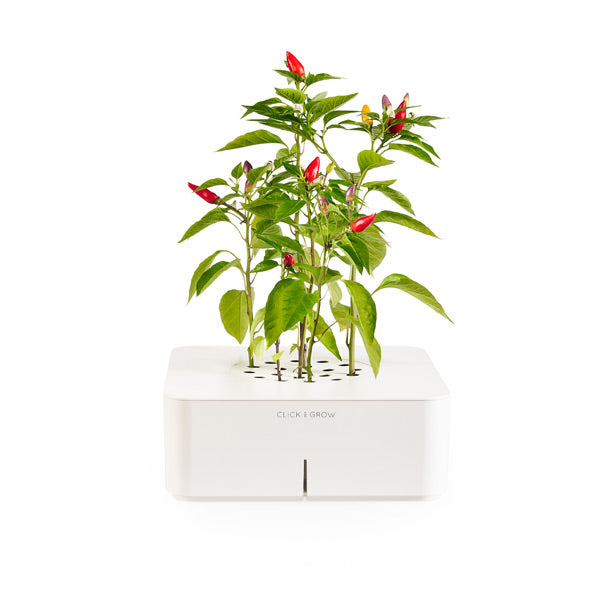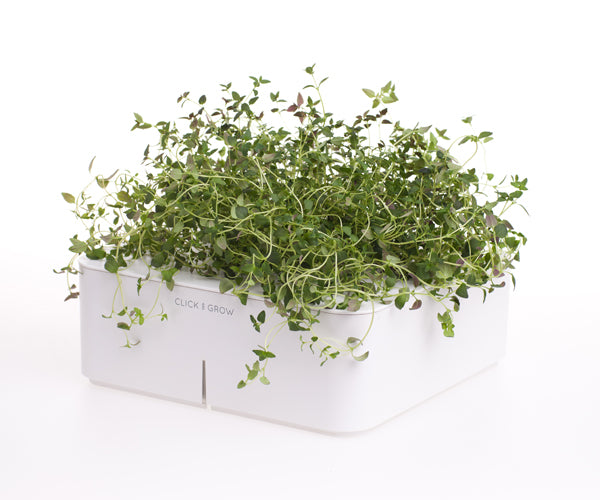Photo: Click & Grow
Please select your shipping region
Looks like you are based in Canada.
Your guide to plants, recipes and much more
Photo: Click & Grow
With the Strawberry Refill for Smart flowerbed being the most anticipated and the most celebrated Smart flowerbed Refill in the history of Click & Grow, we decided to put together a list of must-dos to help you get the most out of it.
But before we begin, let's answer this one question. Why is it so cool to grow strawberries with Click & Grow?
Ever wondered why your Tomato, Strawberry or Chilli Pepper has so little fruits? The answer is simple - they just need some funny business in their life, too. Some so-called "arrangements" or "romantic hangouts with other plants". Basically, your plants simply need to go out on a date, to give you more of those juicy tomatoes and other goodies. And as weird as it sounds, you need to help them... doing it the plant way. Or actually, the bee way.

Here at the Northern hemisphere we are getting ready for winter. Our supporters from Down-Under can skip this section for now.
Basic knowledge is that plants need 3 things to thrive - water, minerals and sunlight. Click & Grow takes care of the first two, so taking care of the light part is the plant owners liability.

Photo: laurenconrad.com
A plant growing in a Click & Grow is almost carefree, but all other houseplants need a little more attention. Today I would like to share with you two great sites that help to understand your plant-pet better.
Basically, the Click & Grow fertilization system is a mineral-organic hybrid.
We reproduce normal "soil" conditions by decomposing organic components by microbiological means. The same mechanism happens in nature - leaves fall and are turned back into soil. This natural plant feeding process is boosted by our hi-tech mineral release system. The latter uses nanotechnology to supply plant roots with elements that are currently in minimum (see picture). This eliminates most of the plants diseases and ails caused by bad nutrition.
What is this peculiar thing that we call the Click & Grow World map? The answer is simple. It's a map of modern gardeners around the world!
The interactive map itself can be found HERE


Stevia or "Sugar Leaf" might not be the poshest representative of the plant kingdom - no bright flowers or coloured leaves, but this plant has some inner qualities that once tried are hard to forget.
Winter has arrived unexpectedly, as usual. In most places around the world it means that plants need much more care than normally. During winter, the most complicated issue for plants is lack of light.
What’s interesting is that people understand the necessity of light differently. A lot of our customers from Brazil complain that they don't have enough light there while customers from Norway confirm they have more light than necessary to grow their plants. We should bear in mind that plants feel light in their own way, not the way we do. How could we know, whether our plant has light enough for sprouting and growing?
Here are some pictures of our customers’ plants and you can clearly see that the plants bend towards the light, desperately searching for it, stretching and suffering from the light stress:

|

|
Every Tuesday we cover the uses and qualities of our edible Click & Grow plants. This week we’ll look at Chili Pepper!

Background
The chili pepper, also known as chile pepper or chilli pepper, is the fruit of plants from the genus Capsicum. It’s estimated that Chili peppers have been a part of the human diet since at least 7500 BC. Archaeological evidence at sites located in Southwestern-Ecuador suggest that chili peppers were domesticated more than 6000 years ago. Astonishing!
Every Tuesday we cover the uses and qualities of our edible Click & Grow plants. This week we’ll look at Lemon Balm.

Background
Lemon Balm (Melissa officinalis) originates from Europe and it has been cultivated in the Mediterranean region for around 2000 years. The plant is widely known for its health benefits. For example, it’s known that Charles V, the King of France in the 14th century, drank Lemon Balm tea every day to stay in good health.
Every Tuesday we cover the uses and qualities of our edible Click & Grow plants. This week we’ll look at Thyme.

Background
Interestingly, there are a number of theories as to the origins of the name thyme. Most agree that its derived from the Greek word thumos or from the Latin fumus which both mean smoke. The association with smoke probably comes from the fact that thyme was used in sacrifices or from the plants fragrant odor, which is often tied with the word fumigate.
What we do know is that thyme originates from the Mediterranean area and in ancient times, thyme was appreciated for its antiseptic properties. For example, Greeks used it as a fumigant while Egyptians made use of its qualities in the embalming process.